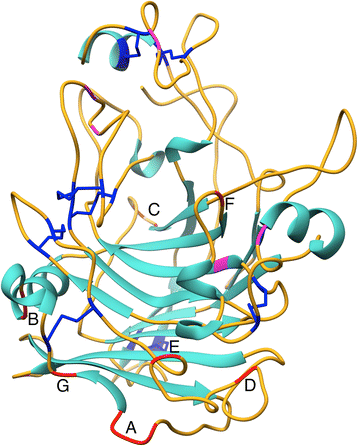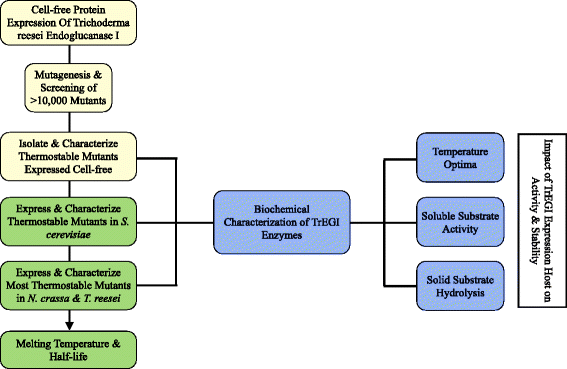Mutagenesis of Trichoderma reesei endoglucanase I: impact of expression host on activity and stability at elevated temperatures
- PMID: 25879765
- PMCID: PMC4347658
- DOI: 10.1186/s12896-015-0118-z
Mutagenesis of Trichoderma reesei endoglucanase I: impact of expression host on activity and stability at elevated temperatures
Abstract
Background: Trichoderma reesei is a key cellulase source for economically saccharifying cellulosic biomass for the production of biofuels. Lignocellulose hydrolysis at temperatures above the optimum temperature of T. reesei cellulases (~50°C) could provide many significant advantages, including reduced viscosity at high-solids loadings, lower risk of microbial contamination during saccharification, greater compatibility with high-temperature biomass pretreatment, and faster rates of hydrolysis. These potential advantages motivate efforts to engineer T. reesei cellulases that can hydrolyze lignocellulose at temperatures ranging from 60-70°C.
Results: A B-factor guided approach for improving thermostability was used to engineer variants of endoglucanase I (Cel7B) from T. reesei (TrEGI) that are able to hydrolyze cellulosic substrates more rapidly than the recombinant wild-type TrEGI at temperatures ranging from 50-70°C. When expressed in T. reesei, TrEGI variant G230A/D113S/D115T (G230A/D113S/D115T Tr_TrEGI) had a higher apparent melting temperature (3°C increase in Tm) and improved half-life at 60°C (t1/2 = 161 hr) than the recombinant (T. reesei host) wild-type TrEGI (t1/2 = 74 hr at 60°C, Tr_TrEGI). Furthermore, G230A/D113S/D115T Tr_TrEGI showed 2-fold improved activity compared to Tr_TrEGI at 65°C on solid cellulosic substrates, and was as efficient in hydrolyzing cellulose at 60°C as Tr_TrEGI was at 50°C. The activities and stabilities of the recombinant TrEGI enzymes followed similar trends but differed significantly in magnitude depending on the expression host (Escherichia coli cell-free, Saccharomyces cerevisiae, Neurospora crassa, or T. reesei). Compared to N.crassa-expressed TrEGI, S. cerevisiae-expressed TrEGI showed inferior activity and stability, which was attributed to the lack of cyclization of the N-terminal glutamine in Sc_TrEGI and not to differences in glycosylation. N-terminal pyroglutamate formation in TrEGI expressed in S. cerevisiae was found to be essential in elevating its activity and stability to levels similar to the T. reesei or N. crassa-expressed enzyme, highlighting the importance of this ubiquitous modification in GH7 enzymes.
Conclusion: Structure-guided evolution of T. reesei EGI was used to engineer enzymes with increased thermal stability and activity on solid cellulosic substrates. Production of TrEGI enzymes in four hosts highlighted the impact of the expression host and the role of N-terminal pyroglutamate formation on the activity and stability of TrEGI enzymes.
Figures




Similar articles
-
Expression of three Trichoderma reesei cellulase genes in Saccharomyces pastorianus for the development of a two-step process of hydrolysis and fermentation of cellulose.J Appl Microbiol. 2014 Jul;117(1):96-108. doi: 10.1111/jam.12494. Epub 2014 Mar 26. J Appl Microbiol. 2014. PMID: 24666670
-
Improving Trichoderma reesei Cel7B thermostability by targeting the weak spots.J Chem Inf Model. 2014 Oct 27;54(10):2826-33. doi: 10.1021/ci500339v. Epub 2014 Oct 6. J Chem Inf Model. 2014. PMID: 25286389
-
Overexpression of an exotic thermotolerant β-glucosidase in trichoderma reesei and its significant increase in cellulolytic activity and saccharification of barley straw.Microb Cell Fact. 2012 May 20;11:63. doi: 10.1186/1475-2859-11-63. Microb Cell Fact. 2012. PMID: 22607229 Free PMC article.
-
[Mechanisms and regulation of enzymatic hydrolysis of cellulose in filamentous fungi: classical cases and new models].Rev Iberoam Micol. 2015 Jan-Mar;32(1):1-12. doi: 10.1016/j.riam.2013.10.009. Epub 2014 Mar 7. Rev Iberoam Micol. 2015. PMID: 24607657 Review. Spanish.
-
Cellulases and beyond: the first 70 years of the enzyme producer Trichoderma reesei.Microb Cell Fact. 2016 Jun 10;15(1):106. doi: 10.1186/s12934-016-0507-6. Microb Cell Fact. 2016. PMID: 27287427 Free PMC article. Review.
Cited by
-
Genome-wide characterization of cellulases from the hemi-biotrophic plant pathogen, Bipolaris sorokiniana, reveals the presence of a highly stable GH7 endoglucanase.Biotechnol Biofuels. 2017 May 25;10:135. doi: 10.1186/s13068-017-0822-0. eCollection 2017. Biotechnol Biofuels. 2017. PMID: 28559926 Free PMC article.
-
Expressing accessory proteins in cellulolytic Yarrowia lipolytica to improve the conversion yield of recalcitrant cellulose.Biotechnol Biofuels. 2017 Dec 11;10:298. doi: 10.1186/s13068-017-0990-y. eCollection 2017. Biotechnol Biofuels. 2017. PMID: 29238402 Free PMC article.
-
Integrated engineering of enzymes and microorganisms for improving the efficiency of industrial lignocellulose deconstruction.Eng Microbiol. 2021 Oct 29;1:100005. doi: 10.1016/j.engmic.2021.100005. eCollection 2021 Dec. Eng Microbiol. 2021. PMID: 39629162 Free PMC article. Review.
-
Engineering Robust Cellulases for Tailored Lignocellulosic Degradation Cocktails.Int J Mol Sci. 2020 Feb 26;21(5):1589. doi: 10.3390/ijms21051589. Int J Mol Sci. 2020. PMID: 32111065 Free PMC article. Review.
-
Engineering cellulases for conversion of lignocellulosic biomass.Protein Eng Des Sel. 2023 Jan 21;36:gzad002. doi: 10.1093/protein/gzad002. Protein Eng Des Sel. 2023. PMID: 36892404 Free PMC article. Review.
References
-
- Viikari L, Alapuranen M, Puranen T, Vehmaanpera J, Siika-Aho M. Thermostable enzymes in lignocellulose hydrolysis. In: Olsson L, editor. Biofuels.vol. 108. Berlin: Springer-Verlag Berlin; 2007. pp. 121–45. - PubMed
Publication types
MeSH terms
Substances
Grants and funding
LinkOut - more resources
Full Text Sources
Other Literature Sources
Molecular Biology Databases

